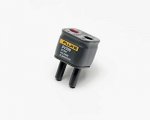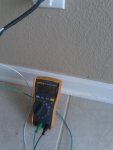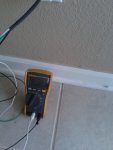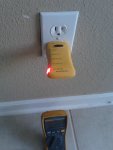Have you tried the tester in a known good receptacle?
Is there any such thing? Even if I brought a new receptacle & breaker, and connected them to a panel...
You don't have to test it at the bungalow in question. Test it at your house. Test it at your shop. Even your "
field-engineer an extension cord with the white & black deliberately reversed" can be tried anywhere, not just at the bungalow. My point was to test the device to see if it is still working as expected (i.e., doesn't have an internal fault which is causing the unexpected reading).
Anyway, I did some digging and found a possible condition that could explain the conditions that you're seeing. If your circuit has an open ground, and some connected device (for example, the air conditioner) is leaking some voltage onto that open ground (which could explain the 3V measured between ground and neutral), and you plug-in your tester, you are now providing a continuity path between the ground and neutral. Current will flow from ground to neutral through the neon lamp in the tester, and will indicate a reverse polarity.
I've also read that some of these neon testers can indicate reverse polarity simply if the circuit ground on that outlet is open, although that wouldn't explain the 119V reading between hot and ground.
My first recommendation is, as I stated previously, to remove the receptacle and see how it's wired. Also, open the distribution panel and check the wiring for that circuit (making sure the neutral and ground are landed properly, and that the neutral bus is properly bonded or not-bonded depending on whether this is the main service panel or sub-panel.
If you can find no obvious wiring problems, then use an extension cord from the distribution panel to get more accurate tests. Make an adapter that has 3 alligator clips with black, white, and green jumper wires to a NEMA 5-15R connector (include some kind of non-conductive cord to anchor the connector near the panel so the alligator clips don't get accidentally pulled off the panel connections). Attach the green clip to the ground bus, the white clip to the neutral bus, and the black clip to the output of the breaker for the circuit being tested. CAUTION: Do not connect to a different breaker or you may inadvertently get the wrong phase. Now you can plug one or more extension cords into your connector to bring your panel connections to the outlet to be tested. This will give you a known good hot, neutral, and ground connection for testing purposes.
I also recommend that you get a
Fluke Stray Voltage Eliminator Adaptor:

This will eliminate "phantom voltage" readings caused by inductance from parallel-running branch circuit conductors. Phantom voltages used to drive me nuts when testing and tracing existing wiring until I got one of these.










